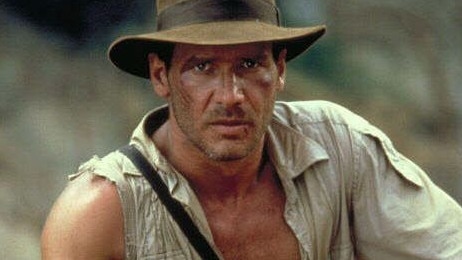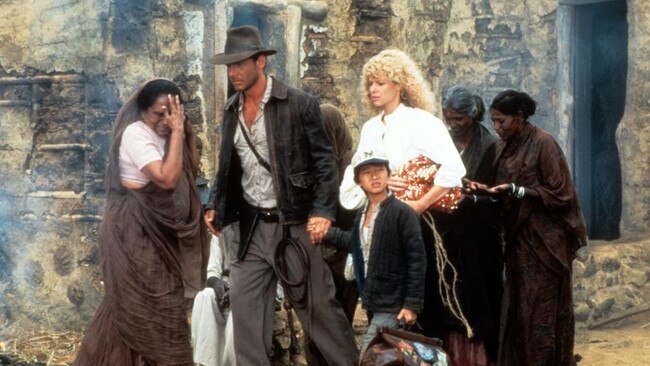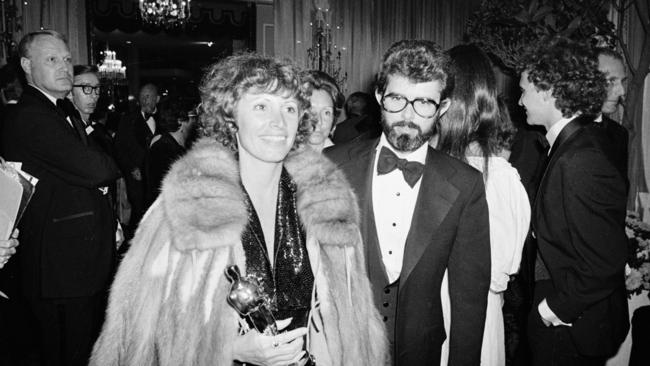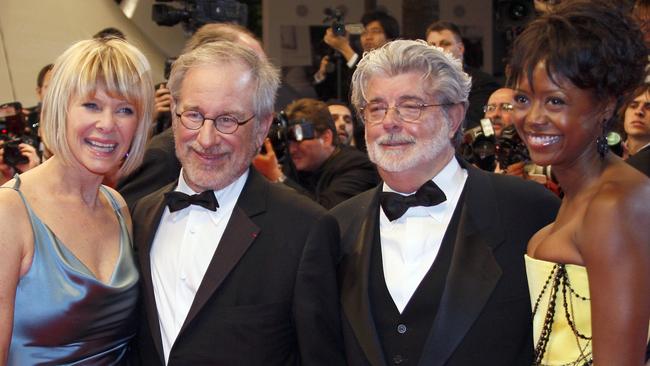How a divorce fuelled nasty streak in Indiana Jones And The Temple Of Doom
Indiana Jones and the Temple of Doom has long been considered the franchise’s darkest instalment — and it’s all thanks to what was happening off-camera.
Movies
Don't miss out on the headlines from Movies. Followed categories will be added to My News.
Indiana Jones And The Temple of Doom has long been considered the darkest entry in the globetrotting archaeology professor’s blockbuster franchise.
Which isn’t to say the other films don’t contain some pure, uncut ’80s nightmare fuel. (The image of Toht’s face melting off in Raiders Of The Lost Ark has been permanently lodged in our collective heads since 1981.)
But 1984’s Temple Of Doom upped the violence and intensity with scenes like Mola Ram (Amrish Puri) removing a heart from a screaming victim, a possessed Indiana Jones (Harrison Ford) attacking his young pal Short Round (Jonathan Ke Quan) and lounge singer Willie (Kate Capshaw) warbling her way through a Busby Berkeley-esque rendition of Anything Goes. (OK, maybe that scene is more awkward than intense …)

Much like fellow kid-targeted 1984 blockbuster Gremlins (also from the Spielberg hit factory), Indiana Jones And The Temple Of Doom pushed the boundaries of “PG” entertainment and caused a public outcry that led the Motion Picture Association of America to create the PG-13 rating.
(Red Dawn earned the honour of being the first movie where parents were strongly cautioned that high schoolers engaged in guerilla warfare against the Soviets should be viewed by ages 13 and up.)
Critics also attacked Temple Of Doom for its reliance on cultural stereotypes (Willie’s over-the-top reaction to the chilled monkey brains and other exotic delicacies served at Pankot Palace smacks of ugly Americanism) and intense scenes of enslaved children in peril. (People Magazine even made the bold claim that parents who took young children to see Temple Of Doom would be committing “cinematic child abuse”.)
While still a box office and home video hit, Temple Of Doom was viewed as a let-down from its beloved predecessor and considered by fans to be the low-point of the franchise until Indiana Jones And The Kingdom Of The Crystal Skull monkey swung its way into theatres in 2008.

So what happened after Raiders that made Temple Of Doom such a downer?
Following the massive success of Raiders Of The Lost Ark, George Lucas felt the need to up the ante for the second Indiana Jones outing and hoped to emulate the darker second act tone that made The Empire Strikes Back such a success. Lucas initially planned to send Indiana to China, where he’d ride a motorcycle along the Great Wall and encounter dinosaurs in a Lost World-style hidden valley. When filming in China proved a no-go, Lucas then toyed with the idea of continuing the supernatural themes from Raiders by setting the sequel in a haunted castle in Scotland.
But Spielberg baulked at working on another ghost story so soon after Poltergeist. So Lucas reteamed with his American Graffiti screenwriters Gloria Katz and Willard Huyck (who were also responsible for the Lucas-produced misfires Howard The Duck and Radioland Murders) to cook up a story, set a year before the events of Raiders, that flung Indiana Jones into his own creepy version of Gunga Din. Originally titled Indiana Jones And The Temple Of Death, the sequel took inspiration from India’s real life Thuggee criminal gang for its tale of dark magic, human sacrifice and bubbling demonic lava.
Lucas has said that Temple Of Doom’s grim tone came in part from the divorce he was going through at the time. He announced his divorce from Marcia Griffin, the Oscar-winning editor of Star Wars who helped to shape much of the original trilogy, in June 1983, just weeks after the release of Return Of The Jedi.

Spielberg had also recently broken up with his girlfriend of three years, music executive Kathleen Carey, who the filmmaker dated following a split from actor Amy Irving. (Spielberg and Irving were later married from 1985 to 1989.)
It’s hard not to view the brittle depiction of the constantly whining Willie, the film’s sole female character, as a reflection of Lucas and Spielberg’s feelings towards women during the making of Temple Of Doom. (Willard Huyck has said that Lucas and Spielberg wanted a “ditzy Jean Harlow type character” as the love interest for Indy in the sequel, and they sadly got their wish.)
Willie’s vain, materialistic characterisation is particularly disappointing coming on the heels of Karen Allen’s iconic performance as the clever and strong-willed Marion Ravenwood.
One has to wonder if the casting of his now-wife Kate Capshaw in such a problematic and unflattering role is at least part of the reason why Spielberg considers Temple Of Doom to be the worst film in the Indiana Jones franchise (it’s not), and one he has said lacks even an ounce of the “personal feeling” the filmmaker puts into his best work.

Despite its flaws, there is much about Temple Of Doom that remains a blast.
The opening sequence in Shanghai and the iconic mine cart chase (two scenes originally intended for Raiders) both have the whip-cracking, Rube Goldberg-ian rush of the franchise’s best moments. Jonathan Ke Quan displays the same skill with one-liners that made Data such a memorable part of The Goonies (attention Spielberg and Lucas — please answer the burning question of what happened to Short Round in the next inevitable Indiana Jones outing) and Mola Ram, indelibly played by the late, great Indian actor Amrish Puri, makes for an effectively creepy baddie. And despite the unfair criticism Kate Capshaw has received over the years for her performance, she has great chemistry with Harrison Ford, particularly in the famous dual bedroom flirtation back-and-forth that inspired a similar scene in Stranger Things season two.
Bigger, louder and coarser than Raiders Of The Lost Ark, Indiana Jones And The Temple Of Doom feels like a product of 1984 in the best and worst sense. It’s also the rare Lucas and Spielberg project that’s both a rollicking good time and a peek into the darker sides of two of the most wholesome big-screen dreammakers.
This article originally appeared on Decider and was reproduced with permission
Originally published as How a divorce fuelled nasty streak in Indiana Jones And The Temple Of Doom


